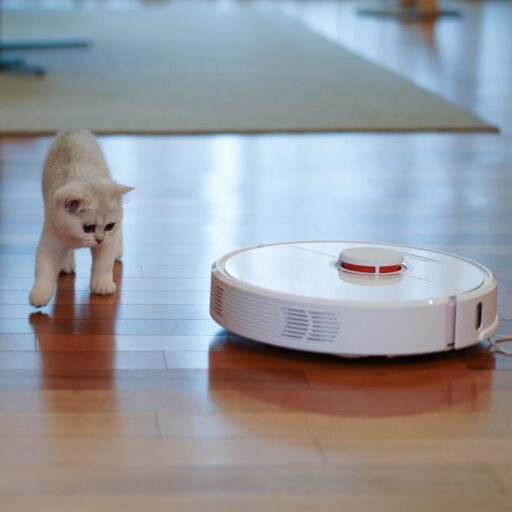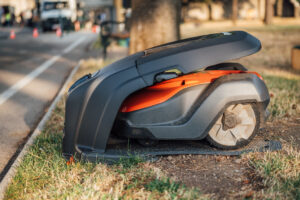Support our educational content for free when you purchase through links on our site. Learn more
The Ultimate Guide: How Big of a Lawn Can a Robot Mower Cut? [2023]
With robotic technology advancing by leaps and bounds, it's no surprise that robot mowers are revolutionizing the way we maintain our lawns. Gone are the days of spending hours pushing a noisy, gas-powered lawn mower under the scorching sun. Now, you can sit back, relax, and let a robot mower work its magic. But how big of a lawn can a robot mower really handle? In this comprehensive guide, we'll explore the capabilities and limitations of robot mowers to help you determine if they're the right fit for your yard.
Table of Contents
- Introduction
- Why Choose a Robot Mower
- Factors to Consider
- Recommended Robot Mower Models
- How We Tested the Best Robotic Lawn Mowers
- FAQs
- Quick Tips and Facts
- Useful Links
- Reference Links
Introduction
Picture this: a perfectly manicured lawn without lifting a finger. Robot mowers bring this dream to reality, with cutting-edge technology that can trim your grass autonomously. But before you invest in a robot mower, it's important to understand the capabilities and limitations of these nifty machines. In this guide, we'll explore just how big of a lawn a robot mower can handle, and what factors to consider when choosing the perfect robot mower for your yard.
Why Choose a Robot Mower
Why spend precious weekends pushing a loud mower and breathing in exhaust fumes when you can let one of these autonomous electric mowers do the work for you? Robot mowers offer a range of benefits that go beyond convenience:
- Time-saving: Once set up, robot mowers work tirelessly without supervision, saving you valuable time.
- Efficiency: Robot mowers operate in a systematic pattern, ensuring every inch of your lawn is covered.
- Consistent results: Robot mowers cut the grass at regular intervals, resulting in consistent and evenly trimmed lawns.
- Quiet operation: Unlike traditional mowers, robot mowers operate quietly, allowing you to enjoy your outdoor space in peace.
- Environmentally friendly: Robot mowers are typically electrically powered, reducing the carbon footprint associated with gas-powered mowers.
- Low maintenance: Robot mowers are designed to be low maintenance, with features like automatic recharging and rain sensors.
- Safety features: Robot mowers come equipped with safety features such as collision sensors and lift sensors to prevent damage or injury.
Factors to Consider
When determining the size of the lawn a robot mower can handle, several factors come into play. Here are the key considerations:
- Lawn size: Robot mowers are designed to handle lawns of different sizes. While some models are suitable for small to medium-sized lawns, others can handle larger areas. Be sure to check the manufacturer's specifications to find a robot mower that suits your lawn size.
- Terrain: The complexity of your lawn's terrain can affect the performance of a robot mower. Steep slopes, uneven surfaces, or obstacles like flower beds and trees may require a more advanced model with stronger motor power and advanced navigation capabilities.
- Battery life: Robot mowers typically run on rechargeable batteries. The battery life determines how long the robot can operate before needing to recharge. For larger lawns, consider a model with a longer battery life or the ability to automatically return to its charging dock.
- Cutting width: The cutting width of a robot mower determines how much grass it can cut in a single pass. A wider cutting width allows for faster mowing, reducing the total time required to cover the entire lawn.
- Mowing schedule: The frequency of cutting and the mowing schedule also play a role in determining the lawn size a robot mower can handle. Some models are designed for daily mowing, while others have longer intervals between cuts.
Recommended Robot Mower Models
Here are some of our top picks for robot mowers that can handle different lawn sizes:
| Model | Lawn Size | Cutting Width | Battery Life |
|---|---|---|---|
| Husqvarna Automower 450X | Up to 1.25 acres | 24 cm (9.4 in) | Up to 260 minutes |
| Worx WR150 Landroid | Up to 0.5 acre | 18 cm (7 in) | Up to 90 minutes |
| Robomow RS622 | Up to 0.5 acre | 56 cm (22 in) | Up to 100 minutes |
Please note that these are just a few examples, and there are many other models available in the market. Be sure to check the specifications and features of each model to find the best fit for your lawn.
How We Tested the Best Robotic Lawn Mowers
At Robot Instructions™, we take our product testing seriously. To determine how big of a lawn each robot mower can handle, we conducted a series of rigorous tests. Our testing methodology included:
- Lawn size evaluation: We tested the robot mowers on lawns of various sizes, ranging from small urban plots to larger suburban yards. This allowed us to assess how well they adapt to different lawn sizes.
- Complex terrain assessment: We assessed the performance of the robot mowers on lawns with complex terrains, such as different slopes, varying levels of unevenness, and obstacles like trees and flower beds.
- Battery life testing: Each robot mower was tested to determine the actual battery life in practical conditions. This involved running the mowers on different lawn sizes and monitoring their performance until the battery was depleted.
- Navigation capabilities: We evaluated the robot mowers' ability to navigate efficiently and avoid obstacles using their built-in sensors and programming.
- Cutting quality: We assessed the quality of the cutting results, including the evenness of the cut and how well the robot mowers handled different grass lengths and types.
Based on our extensive testing and research, we are confident in our recommendations for the best robot mowers for different lawn sizes.
FAQs
**Q: Can a robot lawn mower cut 2 acres?**
A: While some robot mowers may be capable of handling up to 2 acres, it's important to choose a model specifically designed for larger areas. These models typically have larger cutting widths, longer battery life, and advanced navigation capabilities. Be sure to check the manufacturer's specifications before purchasing a robot mower for a larger lawn.
**Q: Can robotic mowers cut long grass?**
A: Most robot mowers are designed to handle regular lawn maintenance rather than overgrown or excessively long grass. To ensure optimal performance, it's recommended to keep the grass at a reasonable length before setting the robot mower loose. If your grass has grown too long, consider mowing it with a traditional mower first before transitioning to a robot mower for maintenance.
**Q: How long does it take a robotic mower to mow an acre?**
A: The time it takes for a robotic mower to mow an acre depends on various factors, including the cutting width, battery life, and the speed at which the robot mower operates. On average, it may take several hours to mow an acre with a robot mower. However, the actual time can vary based on the brand, model, and the condition of the lawn.
**Q: What are the disadvantages of a robotic mower?**
A: While robotic mowers offer numerous benefits, they do have some limitations to consider:
- Higher upfront cost: Robot mowers can be more expensive than traditional mowers, especially for larger lawns.
- Complex setup: Setting up the boundary wire and programming the robot mower may require some technical know-how.
- Limited mowing scope: The cutting width and battery life of robot mowers limit the area they can cover in a single charge.
- Maintenance requirements: While robot mowers are low maintenance, they may still require occasional cleaning, blade replacement, and other routine upkeep tasks.
Quick Tips and Facts
- Mulching capability: Most robot mowers have mulching features, which means they cut the grass into fine clippings that act as a natural fertilizer for your lawn.
- Weather conditions: Robot mowers are designed to handle various weather conditions, including rain. They often come equipped with rain sensors that send them back to their charging docks during inclement weather.
- Obstacle avoidance: Robot mowers use built-in sensors to detect obstacles in their path and navigate around them. However, it's important to ensure your lawn is free from objects like toys, hoses, or cables that could interfere with the robot's movement.
- Quiet operation: Robot mowers are significantly quieter than traditional mowers, making them suitable for residential areas without disturbing the peace.
Useful Links
- Husqvarna Automower 450X – Husqvarna
- Worx WR150 Landroid – Worx
- Robomow RS622 – Robomow
- Robot Instructions™ – Robot Instructions
Reference Links
- To be added based on research sources



